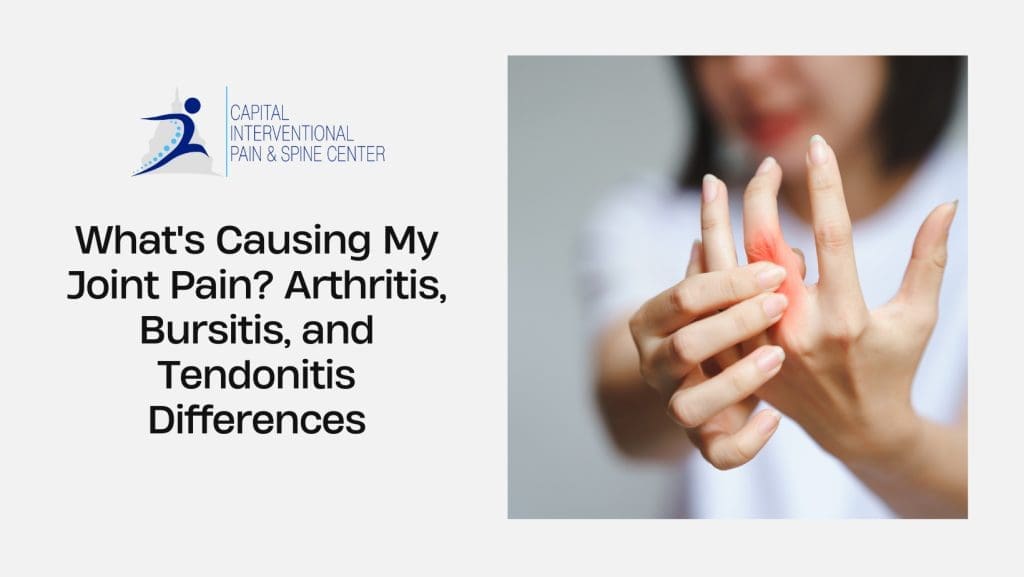Joint pain is a common issue that takes a toll on one’s life, impacting mobility and quality of life. At Capital Interventional Pain & Spine Center, we understand the complexities surrounding joint pain. Many patients seeking help wonder about the causes behind their discomfort and often get confused by the terms “arthritis,” “bursitis,” and “tendonitis.” While these conditions may seem similar due to their association with joint pain, they are distinct in their causes, symptoms, and treatment approaches.
In this blog, we’ll explore the differences between arthritis, bursitis, and tendonitis to help you better understand the nature of the pain and suggest an effective course of action.
What Is Joint Pain?
Joint pain occurs when the structures of the joint become inflamed or irritated. It can involve discomfort, stiffness, swelling, or decreased mobility. Common joints affected include the knees, hips, shoulders, and elbows, but pain can occur in any part of the body where bones meet.
While joint pain may stem from various causes, three of the most common sources are arthritis, bursitis, and tendonitis. Let’s dive into each of these conditions and highlight how they differ from each other.
1. Arthritis: A Common Culprit of Joint Pain
Arthritis refers to swelling of the joint and is considered the natural damage of cartilage over time.
- Osteoarthritis (OA): It is the most known form of arthritis which is prevalent in older adults. Osteoarthritis occurs when the cartilage, protecting the bones, and joint, starts to wear down.
- Rheumatoid Arthritis (RA): It is an autoimmune disorder where the body’s own immune system starts to damage the body’s joints. RA is caused by inflammation within the lining of the joint.
Symptoms of Arthritis:
- Joint pain, tenderness, and swelling
- Stiffness, especially after periods of rest
- Reduced range of motion
- Joint deformities (in advanced stages)
Treatment for arthritis may include medications (pain relievers, anti-inflammatory drugs), physical therapy, or even surgery in severe cases. Our pain management doctors in Maryland specialize in customized treatments for arthritis, including joint injections, which can provide relief and help manage inflammation.
2. Bursitis: Inflammation of the Fluid-filled Sac
When the bursae (small, fluid-filled structures near the bones and muscles) become inflamed, this inflammation is often caused by repetitive movements or prolonged pressure on a joint.
Symptoms of Bursitis:
- The patient feels aching, pain, and soreness in the joints
- Swelling around the affected area
Treatment for bursitis usually involves rest, ice application, and anti-inflammatory medications. In some cases, a joint injection might be required to reduce inflammation and pain. Capital Interventional Pain & Spine Center offers specialized treatments for bursitis to help alleviate discomfort and restore joint function.
3. Tendonitis: Inflammation of the Tendons
Symptoms of Tendonitis:
- Pain and tenderness along the tendon are common symptoms.
- Swelling in the affected area
- Limited range of motion
Unlike arthritis, which involves the joint itself, tendonitis primarily affects the soft tissues around the joint. Usually, ice packs, rest, and anti-inflammatory medication are enough. For more severe cases, interventions like joint injections can help bring down inflammation and improve recovery time.
| Condition | Cause | Affected Area | Common Symptoms | Treatment Options |
|---|---|---|---|---|
| Arthritis | Wear and tear or autoimmune disorder | Joint surfaces (bones) | Pain, stiffness, swelling, decreased mobility | Medications, physical therapy, joint injections, surgery |
| Bursitis | Repetitive motion or pressure | Bursae (fluid sacs) | Pain, swelling, tenderness, restricted movement | Rest, ice, anti-inflammatory meds, joint injections |
| Tendonitis | Overuse or repetitive motion | Tendons (muscle to bone) | Pain, swelling, tenderness, limited mobility | Rest, ice, anti-inflammatory meds, physical therapy, joint injections |
Managing Joint Pain: How a Pain & Spine Center Can Help
Suppose you are experiencing joint pain caused by any of these conditions. In that case, it is important to consult with a pain management doctor in Maryland who can evaluate your symptoms and provide a targeted treatment plan. At Capital Interventional Pain & Spine Center, our specialists use advanced diagnostic techniques to determine the underlying cause of joint pain and recommend the best course of treatment.
Some of the treatments we offer include:
- Joint Injections: Joint injections can be a highly effective solution for conditions like arthritis, bursitis, and tendonitis. These injections reach directly to the site of pain, providing fast relief and reducing inflammation. This may be a steroid/cortisone injection, or a platelet rich plasma (PRP) injection.
- MLS Laser Therapy: MLS Laser Therapy is a non-invasive treatment option can provide significant relief of pain associated with these conditions.
- Physical Therapy: Strengthening the muscles and ensuring safe movements.
- Minimally Invasive Procedures: For patients with more severe pain, minimally invasive procedures, such as peripheral nerve stimulation, radiofrequency ablation, spinal injections, and nerve blocks, may be recommended.
When to Seek Help from a Pain & Spine Center
If your joint and muscle pain interferes with your daily life, and you find it hard to move freely, seek medical attention immediately.
At Capital Interventional Pain & Spine Center, we are dedicated to helping you live a pain-free life. Whether you’re dealing with arthritis, bursitis, tendonitis, or any other joint issue, our team provides comprehensive care to address your needs.
Conclusion
Understanding the differences between arthritis, bursitis, and tendonitis can help you to seek better and more targeted treatment options. Our pain & spine center in Maryland offers a variety of solutions to help you manage and overcome joint pain.
FAQS
What is the main difference between arthritis, bursitis, and tendonitis?
Arthritis involves inflammation of the joint itself. Bursitis affects the fluid-filled sacs (bursae) around joints, typically caused by repetitive movement or pressure. Tendonitis involves the inflammation of tendons, often from overuse or repetitive motion.
What are the common symptoms of arthritis, bursitis, and tendonitis?
The symptoms are swelling, pain, and reduced mobility of the joint, while tendonitis leads to pain, swelling, and limited motion in the tendon area.
How can I treat arthritis, bursitis, and tendonitis at home?
For arthritis, at-home treatments may include rest, ice, and anti-inflammatory medications. Bursitis and tendonitis can often be treated with rest, ice packs, and over-the-counter anti-inflammatory drugs. If symptoms persist, medical intervention may be needed.
What treatments are available at a pain management center for joint pain?
At a pain management center, treatments may include injections, laser therapy, physical therapy, etc. These therapies can provide targeted relief and help restore joint function.

